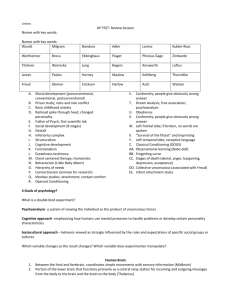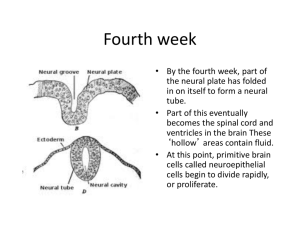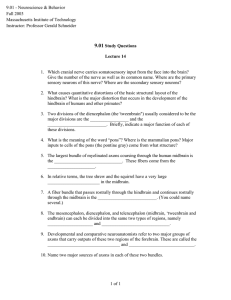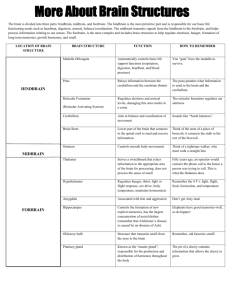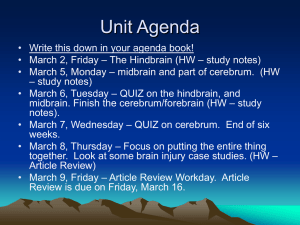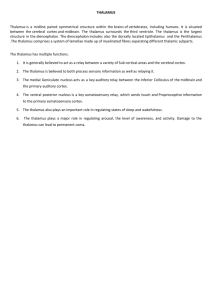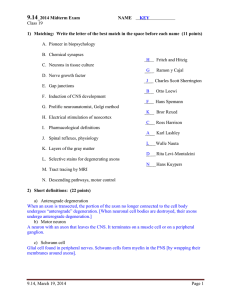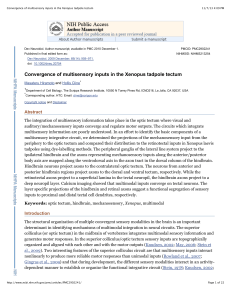corticospinal tract
advertisement
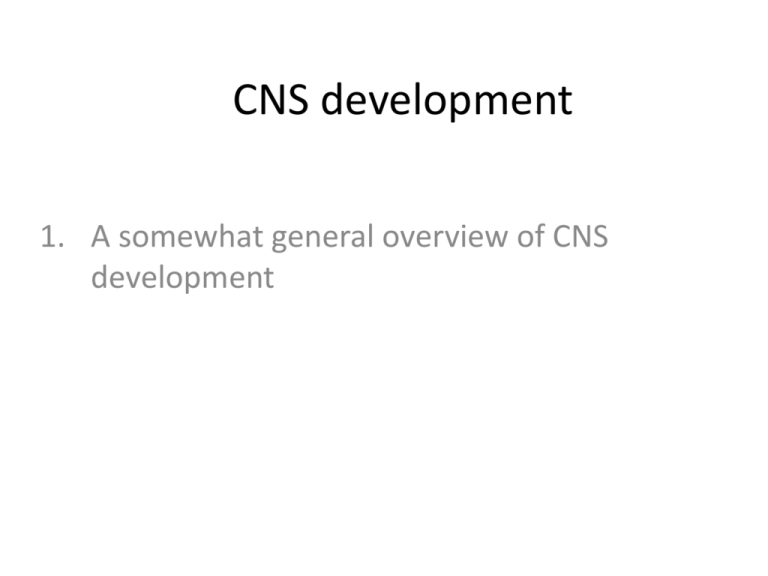
CNS development 1. A somewhat general overview of CNS development In the beginning…… • zygote – fertilized egg; – undergoes a number of divisions with overall size unchanged and divisions resulting in smaller and smaller cells (cleavage) to form the BLASTULA • blastula invaginates giving rise to 3 layers – called gastrulation and the structure is now called a gastrula • blastula invaginates giving rise to 3 layers – gastrulation – endoderm • guts, lungs, liver, internal organs – mesoderm • muscles, skeleton, connective tissue, cardiovascular system, urogenital system – ectoderm • neural groove flattens and forms the neural plate – this folds into a tubular structure called the neural tube The 3 dimensions of the neural tube longitudinal – caudal end – spinal cord rostral end – brain if neural tube fails to close caudal – spina bifida rostral – anencephaly • cavity of the neural tube forms the ventricular system During neurula stage – see further specialization of neural tube cephalic end differentiates into 3 primary vesicles 1. During neurula stage – see further specialization of neural tube 3 swellings at rostral end 1. prosencephalon – forebrain vesicle 2. mesencephalon – midbrain vesicle 3. rhombencephalon – hindbrain vesicle when neurulation is complete – considered an embryo! After 3 vesicles are formed – we see 2 flexures: 1. cervical (sc and hindbrain) 2. cephalic (hindbrain and midbrain) See further specialization of neural tube further divisions – 1. prosencephalon – forebrain vesicle telencephalon - cortex diencephalon – thalamus, hypothalamus 2. mesencephalon – midbrain vesicle 3. rhombencephalon – hindbrain vesicle metencephalon- pons and cerebellum myelencephalon - medulla corticogenesis • - develops from inside out Axon and dendrite development • When does dendritic growth occur? • Environmental influence? Synaptogenesis general terms • • • • nerves tracts ganglion nucleus myelination • What is responsible for myelination? • How long does myelination take? Autonomic NS Somatic NS • 31 pairs of spinal nerves label the diagram • sensory neurons – clustured in DRG – pseudo unipolar neurons • bifurcated axon with central and peripheral branches components of SC • dorsal horn – – sensory relay neurons • ventral horn – – motor nuclei • white matter – – longitudinal tracts of myelinated axons components of SC (con’t) • white matter – – dorsal columns • contains ascending axons carrying somatosensory info – lateral columns • both ascending axons and descending axons – ventral columns • ascending somatosensory and descending axons • corticospinal tract – humans - ~ 1,000,000 axons – originate in motor cortex; pyramidal motor system – makes monosynaptic connections with motor neurons • The corticospinal tract mostly contains motor axons. • The rubrospinal tract – 2ndairy motor system responsible for large muscle movement such as the arms and the legs (flexor and extension, muscle tone). • The spinothalamic tract is a sensory pathway originating in the spinal cord that transmits information about pain, temperature, itch, some measures of touch to thalamus. ways to determine region of spinal cord • relative white to gray matter • configuration of gray matter • specific nuclei- clarkes nucleus Cranial nerves primarily serve head and face Brain • hindbrain, midbrain and forebrain hindbrain • medulla • pons • cerebellum hindbrain (con’t) • medulla structure resembles SC contains: early relay nuclei in taste, hearing, maintenance of balance, neck and facial muscles • pons – ventral portion – pontine nucleus – info about movement and sensation from cc to cerebellum – dorsal portion – respiration, taste, sleep hindbrain • medulla • pons • cerebellum – roles: midbrain • structures: midbrain diencephalon (part of the forebrain) • thalamus – role: • hypothalamus – role: The thalamus communicates with much of the cerebral cortex serving as a sensory and motor information relay. components of the thalamus • nuclei – relay or diffuse projections- classified based on location • internal capsule – large bundle of fibers carrying most of axons running to and from cerebral hemispheres • massa intermedia – connects left and right thalamus • reticular nucleus – role – feedback to output nuclei of thalamus - GABA telencephalon • basal ganglia • limbic system • cerebrum (cerebral hemispheres) telencephalon • cerebrum (cerebral hemispheres) – SOME TERMS: – fissures – large grooves on cerebrum surface – gyrus – outswelling observed on cerebrum – sulci – smaller grooves on cerebrum cerebral cortex layers • distinctive laminar structure of certain cortices provides information regarding region of cortex – ex. Layer IV – main target of sensory info from thalamus telencephalon • cerebrum (cerebral hemispheres) – 4 lobes • primary and association cortices – key differences in primary cortices • What do we know about the extent of innervation as it relates to sensory information? • Explain the statement that functional systems are hierarchically organized. Some questions….. • Differentiate between unimodal association areas and multimodal association areas Prefrontal association area • functions of prefrontal cortex • lesions – • tests of frontal lobe function
